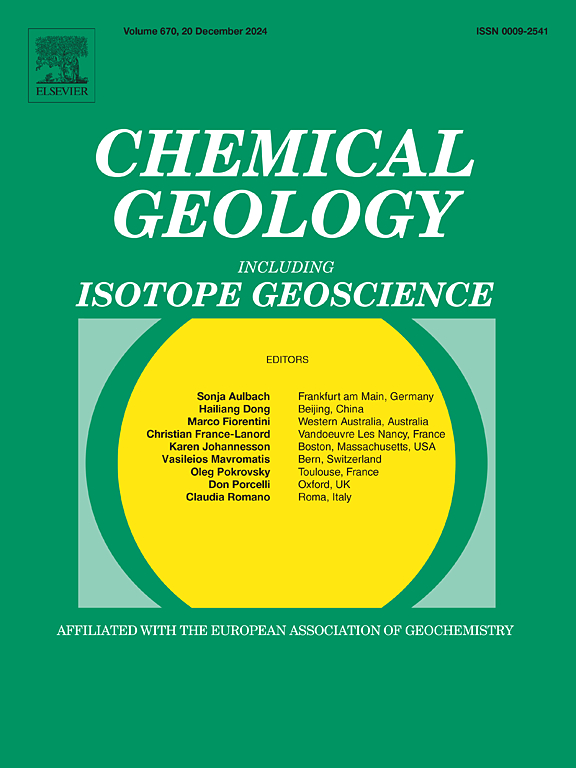Warm magma storage in a continental rift: Insights from U/Th zircon dating and geochemistry of the Salton Buttes
IF 3.6
2区 地球科学
Q1 GEOCHEMISTRY & GEOPHYSICS
引用次数: 0
Abstract
The Salton Rhyolite Buttes, situated within the actively extending Salton Trough, offer a unique opportunity to investigate magma storage conditions in continental rift settings. We present new LA-MC-ICP-MS U![]() Th ages, trace element geochemistry, and Ti-in-zircon thermometry for zircons from all five Salton domes to constrain the timing and nature of past eruptive episodes and magmatic rejuvenation events. Our results reveal a complex history of multiple magmatic and eruptive episodes over the past ∼12,000 years. At Mullet Island, we identify major zircon crystallization events at 11.6 ± 0.6 kyr and 9.8 ± 1.9 kyr, followed by confirmed eruptions between 6 and 8 ka and at 2.3 ka. Obsidian Butte experienced two confirmed eruptions at 1.92 ± 0.06 ka and 5.2 ± 1.2 ka, with significant crystallization periods evidenced by ages of 3.4 ± 0.9 kyr. Rock Hill shows a crystallization event at 4.0 ± 0.9 kyr and a confirmed eruption at 1.8 ± 0.1 ka. The Red Hill domes demonstrate distinct histories: South Red Hill records eruptions at 0.8 ka and 2.5 ± 0.5 ka, with a major crystallization period at 4.7 ± 0.7 kyr, while North Red Hill shows an eruption at 0.8 ka and significant crystallization at 3.1 ± 1.1 kyr. Evidence suggests the presence of a long-lived, interconnected magmatic reservoir that has remained in a warm storage state for over 12,000 years. This finding extends the concept of warm storage, previously documented mainly in arc settings, to continental rift environments. The thin crust, high heat flow, and active extension in the Salton Trough likely facilitate the maintenance of a near-eruptible state over extended periods, even with relatively low magma flux. This has important implications for volcanic hazard assessment and geothermal energy exploration in rift settings. Our study demonstrates that LA-MC-ICP-MS U
Th ages, trace element geochemistry, and Ti-in-zircon thermometry for zircons from all five Salton domes to constrain the timing and nature of past eruptive episodes and magmatic rejuvenation events. Our results reveal a complex history of multiple magmatic and eruptive episodes over the past ∼12,000 years. At Mullet Island, we identify major zircon crystallization events at 11.6 ± 0.6 kyr and 9.8 ± 1.9 kyr, followed by confirmed eruptions between 6 and 8 ka and at 2.3 ka. Obsidian Butte experienced two confirmed eruptions at 1.92 ± 0.06 ka and 5.2 ± 1.2 ka, with significant crystallization periods evidenced by ages of 3.4 ± 0.9 kyr. Rock Hill shows a crystallization event at 4.0 ± 0.9 kyr and a confirmed eruption at 1.8 ± 0.1 ka. The Red Hill domes demonstrate distinct histories: South Red Hill records eruptions at 0.8 ka and 2.5 ± 0.5 ka, with a major crystallization period at 4.7 ± 0.7 kyr, while North Red Hill shows an eruption at 0.8 ka and significant crystallization at 3.1 ± 1.1 kyr. Evidence suggests the presence of a long-lived, interconnected magmatic reservoir that has remained in a warm storage state for over 12,000 years. This finding extends the concept of warm storage, previously documented mainly in arc settings, to continental rift environments. The thin crust, high heat flow, and active extension in the Salton Trough likely facilitate the maintenance of a near-eruptible state over extended periods, even with relatively low magma flux. This has important implications for volcanic hazard assessment and geothermal energy exploration in rift settings. Our study demonstrates that LA-MC-ICP-MS U![]() Th dating can provide high-resolution chronology for young volcanic systems, offering insights into the complex thermal and magmatic evolution of warm storage reservoirs in diverse tectonic environments.
Th dating can provide high-resolution chronology for young volcanic systems, offering insights into the complex thermal and magmatic evolution of warm storage reservoirs in diverse tectonic environments.
大陆裂谷中的温暖岩浆储存:来自索尔顿丘U/Th锆石定年和地球化学的启示
索尔顿流纹岩丘位于积极伸展的索尔顿海槽内,为研究大陆裂谷背景下的岩浆储存条件提供了一个独特的机会。我们提出了新的LA-MC-ICP-MS UTh年龄、微量元素地球化学和锆石ti -in-锆石温度测定,以限制过去喷发事件和岩浆恢复事件的时间和性质。我们的研究结果揭示了在过去~ 12000年里多次岩浆和喷发事件的复杂历史。在Mullet岛,我们确定了主要的锆石结晶事件发生在11.6±0.6 kyr和9.8±1.9 kyr,随后确定的喷发发生在6 - 8 ka和2.3 ka。Obsidian Butte在1.92±0.06 ka和5.2±1.2 ka经历了两次确定的喷发,具有明显的结晶期,年龄为3.4±0.9 kyr。岩石山显示在4.0±0.9 kyr的结晶事件和在1.8±0.1 ka的确定喷发。红山穹隆的历史特征明显:南红山有0.8 ka和2.5±0.5 ka的喷发记录,主要结晶期为4.7±0.7 kyr;北红山有0.8 ka的喷发记录,主要结晶期为3.1±1.1 kyr。有证据表明存在一个长期存在的、相互连接的岩浆储层,它在温暖的储存状态下保持了12000多年。这一发现将以前主要在弧环境下记录的热储存概念扩展到大陆裂谷环境。即使在相对较低的岩浆流量下,索尔顿海槽的薄地壳、高热流和活跃的伸展可能有助于在较长时间内维持近可喷发状态。这对裂谷地区火山危险性评价和地热能勘探具有重要意义。我们的研究表明,LA-MC-ICP-MS UTh定年可以提供年轻火山系统的高分辨率年代学,为了解不同构造环境下储层的复杂热演化和岩浆演化提供了新的思路。
本文章由计算机程序翻译,如有差异,请以英文原文为准。
求助全文
约1分钟内获得全文
求助全文
来源期刊

Chemical Geology
地学-地球化学与地球物理
CiteScore
7.20
自引率
10.30%
发文量
374
审稿时长
3.6 months
期刊介绍:
Chemical Geology is an international journal that publishes original research papers on isotopic and elemental geochemistry, geochronology and cosmochemistry.
The Journal focuses on chemical processes in igneous, metamorphic, and sedimentary petrology, low- and high-temperature aqueous solutions, biogeochemistry, the environment and cosmochemistry.
Papers that are field, experimentally, or computationally based are appropriate if they are of broad international interest. The Journal generally does not publish papers that are primarily of regional or local interest, or which are primarily focused on remediation and applied geochemistry.
The Journal also welcomes innovative papers dealing with significant analytical advances that are of wide interest in the community and extend significantly beyond the scope of what would be included in the methods section of a standard research paper.
 求助内容:
求助内容: 应助结果提醒方式:
应助结果提醒方式:


